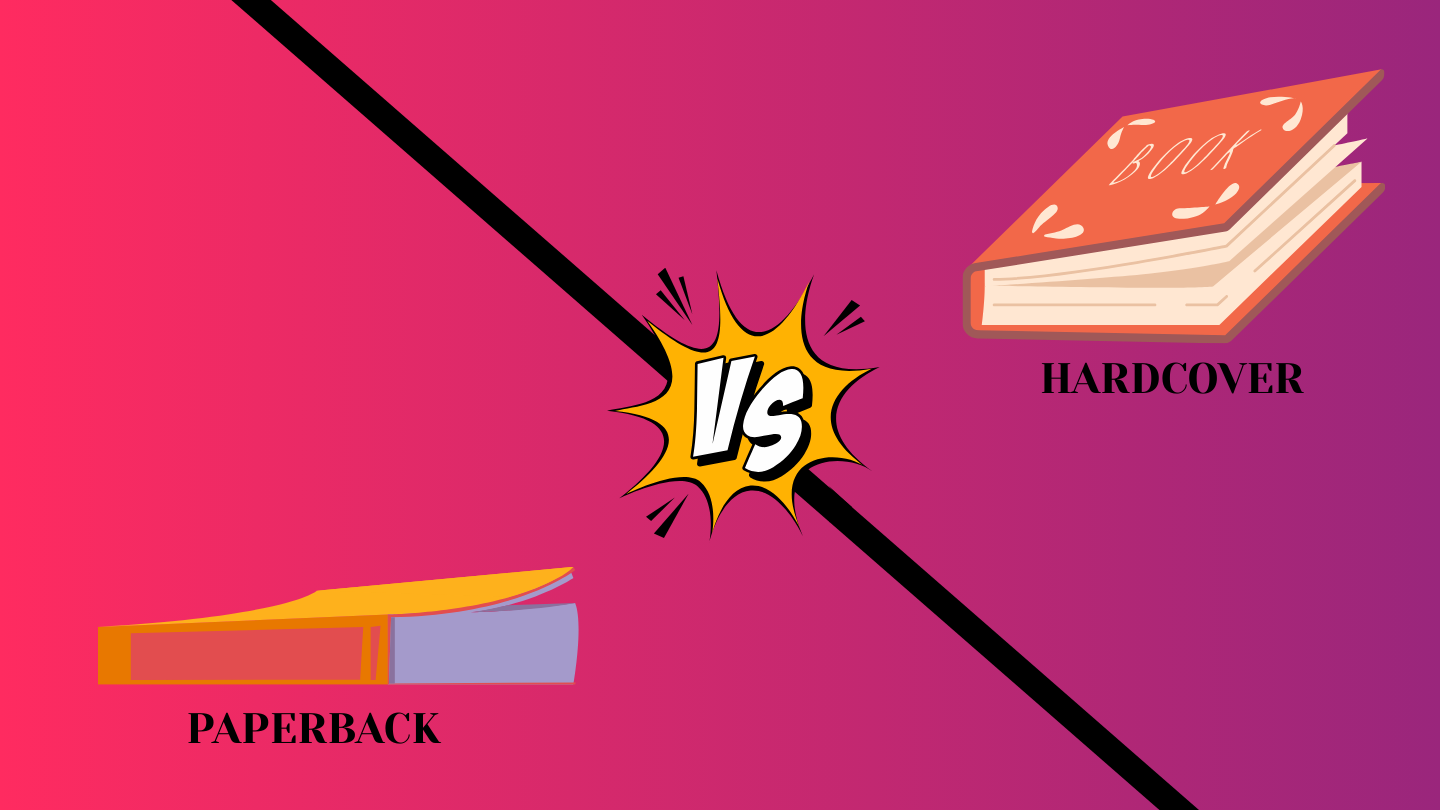Hardcovers: When you want to feel fancy.
Paperbacks: When you want to feel free.
You’re browsing a bookshelf (or scrolling through Amazon), and you spot the same title in two completely different outfits. On one shelf, a stately hardcover dressed in its glossy dust jacket. On another, a comfy paperback with that well-loved, bendable spine.
The difference is not just about the price tag. These two formats offer completely different reading experiences. One’s like your favorite adventure buddy, the other like a family heirloom. So which one’s right for you? Let’s settle the paperback vs. hardcover debate once and for all.
Paperback Book Vs Hardcover: Your Choice Matters More Than You Think
Choosing between paperback and hardcover isn’t about books – it’s about how you live your reading life.
What is paperback vs hardcover?
- Hardcover: It’s like the VIP of book formats –gracing gift shops and collectors’ shelves, but it costs 2-3 times more.
- Paperbacks: They’re the people’s champion, accounting for most fiction sales thanks to their wallet-friendly price and easy-to-carry design
- Here’s a fun fact: Big releases often debut in hardcover first, making the paperback the perfect choice for patient readers
In this blog, we’re going to dig into:
✔ The real price differences (and when paperbacks actually come out ahead)
✔ Which one stands the test of time (hint: libraries don’t swear by hardcovers for nothing)
✔ Reading comfort (ever tried balancing a giant hardcover while reading in bed? It’s a workout!)
Paperback Book Vs Hardcover: What Really Makes Them Different?
Let’s get down to the nitty-gritty of hardcover vs paperback and which is better! At first glance, they might seem similar, but their construction tells a different story:
Paperbacks are like your favorite well-worn jeans:
- Flexible glued spine (called “perfect binding” in book nerd terms)
- Lightweight cardstock covers that bend easily
- Perfect for tossing in your bag or reading with one hand
- The budget-friendly choice dominates impulse buys
Hardcovers are more like a fine leather jacket:
- Pages are stitched together in folded sections before binding
- Rigid board cover dressed up with decorative paper or cloth
- That dust jacket? It’s not just pretty – it’s armor against life’s spills and scratches
- Built to last decades (which is why libraries and collectors adore them)
Hardcover Vs Paperback Price: The Cost Breakdown
Here’s why hardcovers cost more (and when they’re worth it):
Hardcovers aren’t just fancy – they’re built differently with:
- Stitched bindings that can handle heavy use
- Sturdy covers are protected by dust jackets
- Thicker paper resists yellowing over time
Publishers often release hardcovers first, knowing super fans will pay extra for that first edition thrill
Paperbacks? They’re all about keeping reading accessible:
- Glued bindings and flexible covers mean lower production costs
- Priced for readers who want more books for their buck
- Perfect for building a big home library without breaking the bank
Just know they’ll show wear faster. - These are the paperbacks of love, meant to be read and re-read.
Durability Showdown: Which Lasts Longer?
A book’s lifespan hinges on its format. Hardcovers are built to endure, with stitched bindings that survive hundreds of readings without spine cracks. Libraries rely on them for this reason, a well-kept hardcover can circulate for 20+ years. Paperbacks, while portable, show wear faster. Their glued spines weaken with repeated openings and cover curl in humid environments.
Durability Tests:
- Bend Test: Paperbacks fold easily (risking spine creases); hardcovers resist.
- Water Damage: Hardcover jackets protect against spills; paperbacks warp.
- Long-Term Storage: Hardcovers resist yellowing better in sunlight.
Reading Experience: Comfort vs. Practicality
The choice between paperback and hardcover goes beyond cost, it fundamentally changes how you interact with a book. Paperbacks are the undisputed champions of convenience. Their lightweight design and flexible spines make them ideal for one-handed reading, whether you’re curled up on a couch or squeezing in a few pages during your commute. The ability to fold the cover back completely reduces wrist strain during long reading sessions.
Hardcovers offer a more luxurious tactile experience but demand compromises. The rigid covers and heavier weight make them awkward to hold for extended periods without a table or bookstand. However, they excel in presentation laying flat when open for easy note-taking, with crisp typography on higher-quality paper that reduces glare.
Key Differences in Use:
- Portability: Paperbacks win for travel; hardcovers add noticeable bag weight.
- Readability: Hardcovers often use larger fonts and wider margins.
- Aesthetics: Hardcover dust jackets create a polished shelf presence.
Pro Tip:
For thick books (500+ pages), seek “trade paperbacks” they split the difference with sturdier glued spines and lighter weight than hardcovers.
Amazon Hardcover vs. Paperback: What Buyers Should Know
Shopping online adds another layer to the paperback vs. hardcover debate. Amazon listings often show both formats side-by-side, but subtle differences impact your purchase:
- Print Quality Variations
Hardcovers on Amazon typically use the same files as physical bookstore editions, meaning consistent paper quality and ink opacity. Paperbacks especially print-on-demand titles may show slight variations in trim size or cover saturation.
- Shipping Considerations
The flexible nature of paperbacks makes them less prone to damage in transit compared to hardcovers, where dust jackets can slip, and corners may dent. However, hardcovers better protect interior pages from moisture during shipping.
- Return Realities
Amazon’s return policies apply equally, but hardcovers are more likely to arrive in resellable condition if you need to exchange them.
- Pro Tip:
Always check the “Other Formats” tab on Amazon, some publishers offer hardcover/paperback bundles at discounted rates.
Niche Uses: Where Each Format Shines
Not all books are created equal, some genres and use cases heavily favor one format over the other. The paperback book vs. hardcover choice gets nuanced with comics. Paperback trade editions (TPBs) prioritize affordability for readers, while hardcover omnibuses cater to collectors with archival-quality paper and sewn signatures.
Comics Hardcover Vs Paperback: What Should You Know
The “comics hardcover vs. paperback” debate inclines on the purpose of a comic:
- Hardcovers (Omnibus/Artist Editions): Ideal for collectors, with sewn bindings that lay flat for full-page art appreciation. Thick paper prevents ink bleed-through.
- Paperbacks (TPBs): Lightweight and affordable for casual readers, though thin pages may show shadows from reverse-side artwork.
For Cookbooks & Reference Guides
- Hardcovers: Spines withstand frequent flipping; lay flat on countertops. Spill-resistant jackets matter in kitchens.
- Paperbacks: Rare except for budget single-subject guides (e.g., “30-Minute Pasta”).
For Travel & Beach Reading
- Paperbacks: Won’t weigh down your bag. Sand won’t ruin a $12 book.
- Hardcover Exception: Slim hardcovers (like Penguin Mini Classics) for luxury readers.
Pro Tip:
Libraries often sell withdrawn hardcovers for less than paperbacks, check Friends of the Library sales for reference books.
The Final Verdict: Hardcover Vs. Paperback Which Is Better?
So, “hardcover vs paperback which is better?” The answer depends on your priorities:
Choose Hardcover If You Value:
- Longevity: For books you’ll revisit for years (family Bibles, signed editions).
- Prestige: Gifts, displayed collections, or supporting favorite authors.
- Reading Experience: Larger text, archival-quality paper, and lay-flat design.
Choose Paperback If You Prefer:
- Affordability: Building a library without breaking the bank.
- Portability: Commuting, traveling, or reading in odd positions.
- Disposability: Books you’ll donate after one read (airport thrillers).
Final Wisdom:
“Hardcovers are investments; paperbacks are partners in adventure.” Mix both use paperbacks to discover new loves, then upgrade favorites to hardcover.
Pro Tip:
Arkham House Publishers helps authors choose the right format for their audience.





